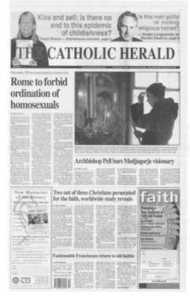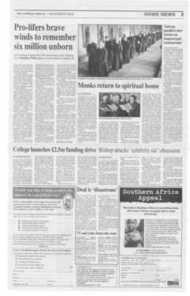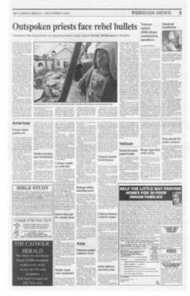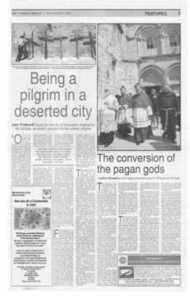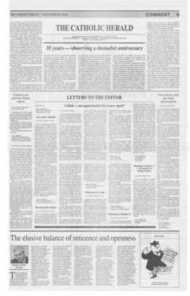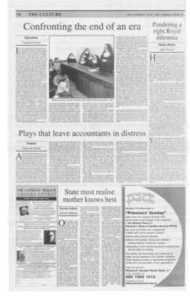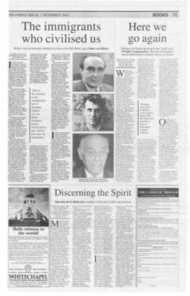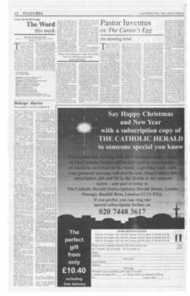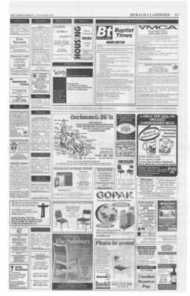Page 2, 1st November 2002
Page 2
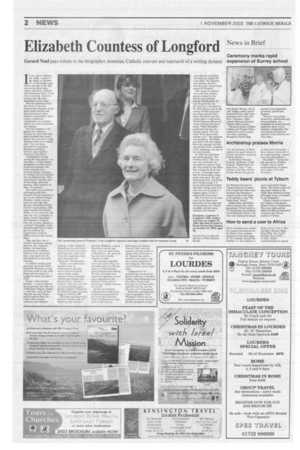
Report an error
Noticed an error on this page?If you've noticed an error in this article please click here to report it.
Tags
Share
Related articles
Reflections On A Long And Fertile Life
Memorial Mass For Lady Longford
The His Cory Women Part I: At 90, The Mother Of A...
Oldie Honours Longfords Frank And Elizabeth Longford Were...
Francis Aungier Pakenham, 7th Earl Of Longford
Elizabeth Countess of Longford
Gerard Noel pays tribute to the biographer, historian, Catholic convert and matriarch of a writing dynasty
It was a great sadness, last week, to read of the death on October 23, of Elizabeth Longford at the age of 96. She was a truly great lady, warm, charming, brilliant and immensely kind. It was VeTy consohng, however, to learn that she died peacefully in her sleep.
Her life spanned nearly the whole of the last century and, because of her great achievements and unconventional views, formed a particularly interesting companioncommentary to a century which saw such revolutionary changes.
The first degrees to be gained by women at Oxford (in 1921) had only been awarded four years before she went up to Lady Margaret Hall on a scholarship. This had been preceded by attending Headington School, Oxford, and a spell at Grenoble University.
Undaunted by being among the tiny group — at that time — of girl undergraduates in a male-dominated environment, she took a second class honours degree in Greats or, as they call it at Oxford, Literae Humaniores. This represented a notable feat of matching, and even beating, male students on their own ground.
Her early non-conformist upbringing had been tempered by her reaction to her second school, Francis Holland, where, even at such an early age, she became interested in High Church Anglicanism, with vague tendencies toward Rome. It was, however, the man she was eventually to marry, Frank Pakenham, who became a Catholic first. He, in turn, helped to "convert" Elizabeth, while she persuaded him to abandon his work at the Conservative Central Office and join the Labour Party.
They had first met at Oxford, but Frank, though taken by the vivacious beauty who had been something of a Zuleika Dobson in her university days, was much too shy and inhibited to do much courting.
A notable turning point occurred, however, when Elizabeth (Harman, as she still was) went to stay with Frank and his family in Ireland towards the end of 1930.
Frank's elder brother Edward — Lord Longford and proprietor after the war of the Gate Theatre, Dublin — told me a story of how, after tea one day, Frank and Elizabeth went for a walk in the autumn sunshine, and returned looking "rather sheepish". Something was obviously afoot, but it was not until a year later that, when both were still Anglicans, they were married at St Margaret's, Westminster.
Frank, soon afterwards, became a don of Christchurch, and they went to live in Oxford, where Frank, partly because of his friendship with Evelyn Waugh and Ronnie Knox, became a Catholic. The war was still on when Elizabeth gave gallant support to Frank in his effort to unseat Quentin Hogg as Oxford's MP.
Elizabeth had meanwhile become friendly with the charming, but eccentric Gervase Matthew, a noted Byzantine scholar and friar, who was then living at Blackfriars. He received her into the Catholic Church in 1946.
Having been expelled from the Labour Party for not adhering to its official policy of maintaining a party political truce during the war, Elizabeth now turned her attention to raising a magnificent and talented family, and to becoming a highly successful author.
Books and children followed each other in an impressive succession in the years that followed. Some of Elizabeth's work, such as her lives of Wellington and Queen Victoria, have become classics, and she wrote or edited about 20 books in all. Despite her earlier socialist convictions, she was a great supporter of the monarchy and wrote some brilliant royal biographies.
I happened to be researching a book in the Royal Archives in Windsor Castle, when Elizabeth was also there. Every midmorning we all had coffee together and she was the life and soul of the group.
While her contemporary royal biographer, Cecil Woodham-Smith sent an assistant to do her research for her, Elizabeth always came herself and deftly charmed the highly efficient staff. The registrar told me that she was known as the "uncrowned queen of Windsor".
Her range of subjects was wide and eclectic, greatly helped by her friend and publisher George Weidenfeld. On one occasion he was driving her to Scotland in his Rolls-Royce and in the course of their long journey discussed her next book. Elizabeth said she would like to write about Wilfrid Scawen Blount of whom George had never heard. When Elizabeth explained who he was, George asked: "Do you really think that would interest you?" His question was prophetic. Elizabeth got bored with her subject half-way through the writing and the book, comparatively speaking, was one of her rare failures.
In 1986 she published her autobiography, The Pebbled Shore. She was not, she confessed, an introspective person, and she was struck by the effect that writing the book had on her. "It brought home that all these happy times really were past, the children being born, and Frank and I being young. I'd never quite acknowledged that these things were over and were never going to happen again. It was a melancholy discovery."
She will live on for many years in the hearts and memories of her large and loving family, her literary triumphs and her many admirers and friends.
Elizabeth, Countess of Longford, CBE, author, was born on August 30, 1906. She died at home in Hurst Green, East Sussex, on October 23, 2002. aged 96.
Gerard Noel is editorial director of The Catholic Herald
blog comments powered by Disqus


